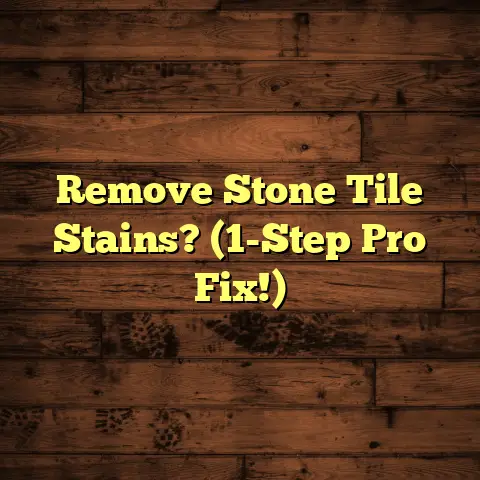DIY Epoxy Floor Kits Worth It? (6 Hidden Costs!)
One trend I’ve been seeing a lot is epoxy flooring. It’s popping up everywhere from garages to living rooms, and honestly, it looks pretty darn cool.
That glossy, seamless finish is a major draw, and the fact that you can customize it with colors, flakes, and even embedded objects? Seriously appealing. And that’s where DIY epoxy floor kits come in – promising a personalized space without the hefty price tag of professional installation.
But let’s be real, as a flooring contractor with years under my belt, I’ve seen enough DIY projects gone sideways to know that things aren’t always what they seem. So, are these DIY epoxy floor kits really worth it? Or are there hidden costs lurking beneath that shiny surface, waiting to drain your wallet and your sanity? Let’s dive in and find out!
Section 1: Understanding Epoxy Flooring
So, what is epoxy flooring anyway?
Simply put, it’s a thermosetting polymer that’s applied as a liquid and then hardens into a solid, durable surface. It’s made by mixing two parts: an epoxy resin and a hardener (also called a catalyst). When these two combine, a chemical reaction occurs, creating a rigid plastic material.
Think of it like super-strong, super-shiny glue that bonds to your existing floor.
Now, why is epoxy flooring so popular? Well, for starters, it’s incredibly durable. I’m talking resistant to scratches, stains, impacts, and even some chemicals. That’s why you see it so often in garages and industrial settings.
But it’s not just about toughness.
Epoxy is also incredibly versatile aesthetically. You can get it in a huge range of colors, add metallic pigments for a shimmering effect, or incorporate decorative flakes for texture and visual interest. It’s this versatility that makes it so attractive for blending styles. Want an industrial loft look? Go for a simple gray epoxy. Craving something more modern? A glossy white epoxy with subtle metallic accents can do the trick.
And let’s not forget about maintenance.
Epoxy floors are super easy to clean – a quick sweep and mop, and you’re good to go. No more struggling with grout lines or worrying about stains soaking into the material.
DIY epoxy kits offer a variety of styles and finishes. You’ll find solid colors, metallic epoxies, flake systems, and even clear epoxies that you can customize with your own embellishments. This makes it easy to tie in different design elements and create a cohesive look throughout your home.
Section 2: The Allure of DIY
Let’s face it, DIY is HUGE right now.
From Pinterest projects to YouTube tutorials, everyone’s trying their hand at home improvement. And flooring is no exception. I’ve seen a massive uptick in people tackling their own flooring projects, and DIY epoxy kits are a big part of that.
Why the appeal?
Well, the biggest draw is probably the cost savings. Professional epoxy installation can be pricey, especially for larger areas. Doing it yourself can save you a significant chunk of change.
Plus, there’s the satisfaction of creating something yourself. I think we all have that inner artist yearning to break free. DIY epoxy lets you unleash your creativity and personalize your space in a way that reflects your unique style.
I remember one homeowner, Sarah, who completely transformed her drab garage into a vibrant workspace with a DIY epoxy floor. She used a metallic blue epoxy with silver flakes, and the result was stunning. She told me she felt a huge sense of accomplishment knowing she had done it all herself.
And I get it. There’s something incredibly rewarding about taking on a project and seeing it through to completion. But, and this is a big but, it’s important to go into these projects with your eyes wide open.
Section 3: Hidden Costs of DIY Epoxy Floor Kits
Okay, let’s get down to the nitty-gritty.
While DIY epoxy kits can seem like a budget-friendly solution, there are often hidden costs that can quickly add up and turn your dream project into a financial nightmare. I’ve seen it happen time and time again.
Here are six hidden costs to be aware of:
Cost 1: Preparation and Repair Costs
This is where most people underestimate the work involved. Epoxy is NOT forgiving. It needs a perfectly clean, smooth, and level surface to adhere properly. And I mean perfectly.
If your existing floor has cracks, holes, or uneven spots, you’ll need to repair them before applying the epoxy. This could involve patching cracks with concrete filler, leveling the floor with a self- leveling compound, or even grinding down high spots.
These repairs can be surprisingly expensive.
A bag of self-leveling compound can cost anywhere from $30 to $50, and you might need several bags depending on the size of your floor. Grinding equipment can be rented for around $50 to $100 per day. And if you’re dealing with major damage, you might even need to hire a professional to do the repairs, which can cost hundreds or even thousands of dollars.
I had one client who skipped the prep work and went straight to applying the epoxy. The result? A bumpy, uneven floor that looked terrible. He ended up having to remove the entire epoxy coating and start over, doubling his costs and wasting a ton of time.
Pro Tip: Don’t skimp on the prep work! It’s the foundation of a successful epoxy floor.
Cost 2: Tools and Equipment
DIY epoxy kits often include the basic materials you need, like the epoxy resin, hardener, and maybe some decorative flakes. But they rarely include all the tools and equipment required for a professional- looking installation.
Here’s a list of essential tools you’ll likely need:
- Concrete Grinder: For removing old coatings, smoothing rough surfaces, and opening the concrete pores for better adhesion.
- Diamond Grinding Pads: Different grits for various stages of grinding.
- Shop Vacuum: For removing dust and debris.
- Mixing Buckets: For mixing the epoxy resin and hardener.
- Mixing Drill with Paddle Attachment: For thoroughly mixing the epoxy.
- Squeegee: For spreading the epoxy evenly.
- Spiked Roller: For removing air bubbles.
- Paint Roller and Extension Pole: For applying the epoxy to vertical surfaces.
- Safety Glasses, Gloves, and Respirator: Protecting yourself from harmful chemicals.
- Solvent: For cleaning tools and spills.
These tools can easily add up to several hundred dollars. And if you don’t already own them, you’ll need to factor in the cost of renting or buying them.
Pro Tip: Check the kit carefully to see what’s included and what you’ll need to purchase separately.
Cost 3: Time Investment
Time is money, right?
DIY projects always take longer than you think they will. And epoxy flooring is no exception. From preparing the floor to applying the epoxy to waiting for it to cure, the entire process can take several days, or even a week, depending on the size of the area and the complexity of the design.
This time commitment can be a hidden cost in several ways. First, you might need to take time off work to complete the project. Second, you might need to hire someone to help you, especially if you’re working on a large area. And third, if things go wrong, you could end up spending even more time fixing the mistakes.
I had one client who tried to install an epoxy floor in his garage over a weekend. He quickly realized that he had underestimated the amount of time it would take. He ended up rushing the job, which resulted in a poorly applied coating with lots of air bubbles. He then had to spend another weekend fixing the mistakes.
Pro Tip: Be realistic about the time commitment involved and plan accordingly.
Cost 4: Quality of Materials
Not all epoxy is created equal.
DIY epoxy kits often use lower-quality materials than professional-grade epoxy flooring solutions. This can impact the longevity and performance of your floor.
Lower-quality epoxy may be less resistant to scratches, stains, and chemicals. It may also be more prone to peeling and cracking. And it may not last as long as professional-grade epoxy, meaning you’ll need to replace it sooner.
I’ve seen DIY epoxy floors that start to show signs of wear and tear within a year or two, while professionally installed epoxy floors can last for decades.
The difference in price between DIY kits and professional-grade epoxy can be significant. But in the long run, the higher-quality materials will save you money by lasting longer and requiring less maintenance.
Pro Tip: Research the different types of epoxy available and choose a kit with high-quality materials.
Cost 5: Maintenance and Repair
Even with high-quality materials, epoxy floors require some maintenance. And improper installation can lead to costly repairs down the line.
If the epoxy is not applied correctly, it can peel, crack, or bubble. These problems can be difficult and expensive to fix. You might need to grind down the affected area, reapply the epoxy, and then recoat the entire floor.
Also, while epoxy is durable, it’s not indestructible. It can be damaged by heavy objects, sharp objects, or certain chemicals. If you damage your epoxy floor, you’ll need to repair it to prevent further damage.
Pro Tip: Follow the manufacturer’s instructions carefully and take precautions to protect your epoxy floor from damage.
Cost 6: Aesthetic Compromises
Let’s be honest, DIY projects rarely look as good as professional installations. And epoxy flooring is no exception.
Even if you’re meticulous and follow all the instructions, there’s a good chance your DIY epoxy floor won’t look as flawless as a professionally installed floor. You might have some imperfections, like slight variations in color, minor air bubbles, or uneven spots.
These imperfections might not bother you, but they could detract from the overall look of your space. And if you’re not happy with the finished result, you might end up spending more money to have it professionally redone.
I had one client who was so disappointed with her DIY epoxy floor that she ended up hiring me to remove it and install a new one. She said she wished she had just hired me in the first place.
Pro Tip: Be realistic about your skills and expectations. If you’re looking for a perfect, flawless finish, you might be better off hiring a professional.
Section 4: Evaluating Whether DIY Epoxy Kits are Worth It
So, are DIY epoxy floor kits worth it?
The answer, as always, is it depends. It depends on your skills, your budget, your time, and your expectations.
If you’re a skilled DIYer with plenty of time and patience, and you’re willing to invest in high- quality materials and tools, then a DIY epoxy floor kit might be a good option for you.
However, if you’re not comfortable with DIY projects, if you’re on a tight budget, or if you’re looking for a perfect, flawless finish, then you’re probably better off hiring a professional.
I’ve seen successful DIY projects where homeowners took their time, did their research, and followed instructions meticulously. The results were impressive and saved them a significant amount of money.
On the other hand, I’ve also seen DIY disasters where homeowners ended up spending more money fixing their mistakes than they would have spent hiring a professional in the first place.
Case Study: A local mechanic decided to epoxy his garage floor himself using a DIY kit. He was confident in his abilities but didn’t realize the importance of grinding the concrete properly. The epoxy started peeling within months, and he had to hire a professional to redo the entire floor. The cost of the DIY kit, plus the professional repair, ended up being far more than if he had hired a pro from the start.
Expert Opinion: Talking with other contractors, the consensus is that DIY epoxy can be a viable option for small, simple projects. However, for larger or more complex projects, the risk of errors and the potential for costly repairs make it a less attractive option.
Before you decide whether to DIY or hire a pro, ask yourself these questions:
- How comfortable am I with DIY projects?
- Do I have the time and patience to do the job right?
- Am I willing to invest in high-quality materials and tools?
- What are my expectations for the finished result?
- What’s my budget?
Conclusion
DIY epoxy floor kits can be a tempting option for homeowners looking to save money and personalize their spaces. The allure of a glossy, seamless floor that you created yourself is undeniable.
However, it’s crucial to be aware of the hidden costs involved. From preparation and repair costs to tool and equipment expenses, the costs can quickly add up and turn your dream project into a financial burden.
Before you embark on a DIY epoxy flooring project, take the time to weigh your options carefully. Consider your skills, your budget, and your long- term vision for your space.
If you’re confident in your abilities and willing to invest the time and money required, then a DIY epoxy floor kit might be a worthwhile option. But if you’re not comfortable with DIY projects or if you’re looking for a perfect, flawless finish, then you’re probably better off hiring a professional.
Ultimately, the decision is yours. But by being aware of the hidden costs and carefully considering your options, you can make an informed choice that’s right for you.
Now, I’m curious to hear from you! Have you ever tried a DIY epoxy flooring project? What was your experience like? Did you encounter any hidden costs? Share your stories in the comments below!





